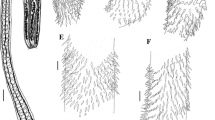Abstract
A new species of trypanorhynch cestode is described from two species of stingrays, the Panamic stingray Urotrygon aspidura (Jordan & Gilbert) and the Pacific chupare Himantura pacifica (Beebe & Tee-Van) collected in the Golfo de Montijo in the Eastern Pacific Ocean off the coast of Panama. Shirleyrhynchus panamensis n. sp. represents an important addition to the family, which until now consisted of two monotypic genera. The new species is characterised by an elongate scolex with four, ovate bothria, presence of prebulbar organs, absence of gland cells within the muscular bulbs and an oncotaxy with a typical heteroacanthous, heteromorphous tentacular armature, a characteristic basal armature and the presence of a slight basal swelling. It is readily distinguished from its congeners by a smaller scolex and features of the oncotaxy, such as dissimilar hooks on opposing principle rows, a commencement of hook rows from the bothrial to the antibothrial surface and a much shorter basal armature. Although described only on the basis of immature worms lacking a strobila, the new species adds information on features of the oncotaxy within Shirleyrhynchus Beveridge & Campbell, 1988. Observation of the holotype of Shirleyrhynchus aetobatidis (Shipley & Hornell, 1906) revealed apparent differences from Australian specimens that have been described as Shirleyrhynchus butlerae Beveridge & Campbell, 1988 but which were later synonymised. Observations of type-specimens of S. butlerae also revealed differences from the original description and some morphological characteristics are amended. Shirleyrhynchus butlerae is herein resurrected and an amended generic diagnosis and a key to the identification of species are provided. The molecular voucher specimen of ‘S. aetobatidis’ utilised in previous molecular phylogenetic studies was re-observed which revealed a misidentification of the specimen with Parachristianella indonesiensis Palm, 2004.






Similar content being viewed by others
References
Beveridge, I., & Campbell, R. A. (1988). Cetorhinicola n. g., Shirleyrhynchus n. g. and Stragulorhynchus n. g., three new genera of trypanorhynch cestodes from elasmobranchs in Australian waters. Systematic Parasitology, 12, 47–60.
Beveridge, I., & Campbell, R. A. (1998). Re-examination of the trypanorhynch cestode collections of A.E. Shipley, J. Hornell and T. Southwell, with the erection of a new genus, Trygonicola, and redescriptions of seven species. Systematic Parasitology, 39, 1–34.
Campbell, R. A., & Beveridge, I. (1994). Order trypanorhyncha diesing, 1863. In L. F. Khalil, A. Jones, & R. A. Bray (Eds.), Keys to the cestode parasites of vertebrates. Wallingford: CAB International, pp. 51–148.
Carvajal, J., & Campbell, R. A. (1975). Rhinoptericola megacantha gen. et sp. n., representing a new family of trypanorhynch cestodes from the cownose ray, Rhinoptera bonasus (Mitchill, 1815). Journal of Parasitology, 61, 1023–1030.
Chervy, L. (2009). Unified terminology for cestode microtriches: a proposal from the International Workshops on Cestode Systematics in 2002-2008. Folia Parasitologica, 56, 199–230.
Dollfus, R-Ph. (1942). Études critiques sur les Tétrarhynques du Muséum de Paris. Archives du Muséum national d’Histoire naturelle, Paris, 19, 1–466.
Naylor, G. J. P., Caira, J. N., Jensen, K., Rosana, K. A. M., White, W. T., & Last, P. R. (2012). A DNA sequence-based approach to the identification of shark and ray species and its implications for global elasmobranch diversity and parasitology. Bulletin of the American Museum of Natural History, 367, 1–262.
Olson, P. D., Caira, J. N., Jensen, K., Overstreet, R. M., Palm, H., & Beveridge, I. (2010). Evolution of the trypanorhynch tapeworms: Parasite phylogeny supports independent lineages of sharks and rays. International Journal for Parasitology, 40, 223–242.
Palm, H. W. (2004). The trypanorhyncha diesing, 1863 (p. 710). Bogor: PKSPL-IPB Press.
Palm, H. W. (2010). Nataliella marcelli n. g., n. sp. (Cestoda: Trypanorhyncha: Rhinoptericolidae) from Hawaiian fishes. Systematic Parasitology, 75, 105–115.
Palm, H. W., Waeschenbach, A., Olson, P., & Littlewood, T. (2009). Molecular phylogeny and evolution of the trypanorhyncha diesing, 1863. Molecular Phylogenetics and Evolution, 52, 351–367.
Pintner, T. (1913). Vorarbeiten zu einer Monographie der Tetrarhynchoideen. Sitzungsberichte der Kaiserlichen Akademie der Wissenschaften in Wien. Mathematisch-Naturwissenschaftliche Klasse, 122, 1–83.
Schaeffner, B. C., & Beveridge, I. (2014). The trypanorhynch cestode fauna of Borneo. Zootaxa, 3900, 21–49.
Shipley, A. E., & Hornell, J. (1906). Cestode and nematode parasites from the marine fishes of Ceylon. Report to the Government of Ceylon on the Pearl Oyster Fisheries of the Gulf of Manaar. London: Royal Society, pp. 43–96.
Acknowledgements
Special thanks are due to Dr Fernando Marques, Bruna Trevisan (both Universidade de São Paulo, USP, Brazil) and Dr Florian Reyda (State University of New York, USA) for their collaboration and sampling efforts in Panama. I am deeply indebted to Dr Ian Beveridge (University of Melbourne, Australia) and Sara Dallarés Villar (Universitat de Barcelona, Spain) for examining and providing essential information on the type-series of S. butlerae from the South Australian Museum in Adelaide (I.B.) and examining and providing line drawings of the oncotaxy of the holotype of S. aetobatidis in the Naturhistorisches Museum in Vienna and (S.D.V.). I am very grateful to Dr Janine N. Caira (University of Connecticut, USA) for providing essential photomicrographs of the hologenophore deposited in the L. R. Penner collection at the University of Connecticut. Thanks are due to Dr Leslie Chisholm (South Australian Museum, Australia) for providing specimens of the type-series of S. butlerae. Phillip Lenktaitis (USP) operated the scanning electron microscope with a lot of patience for which I am grateful.
Funding
Financial support was provided by the post-doctoral fellowship of the Fundação de Amparo á Pesquisa do Estado de São Paulo (FAPESP, Brazil) (No. 2014/10220-0).
Author information
Authors and Affiliations
Corresponding author
Ethics declarations
Conflict of interest
The author declares that he has no conflict of interest.
Ethical approval
All applicable institutional, national and international guidelines for the care and use of animals were followed.
Rights and permissions
About this article
Cite this article
Schaeffner, B.C. Review of the genus Shirleyrhynchus Beveridge & Campbell, 1988 (Trypanorhyncha: Shirleyrhynchidae), with the resurrection of S. butlerae Beveridge & Campbell, 1988 and the description of S. panamensis n. sp.. Syst Parasitol 93, 413–430 (2016). https://doi.org/10.1007/s11230-016-9641-0
Received:
Accepted:
Published:
Issue Date:
DOI: https://doi.org/10.1007/s11230-016-9641-0




